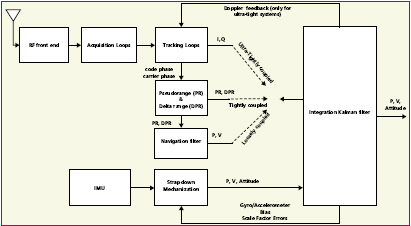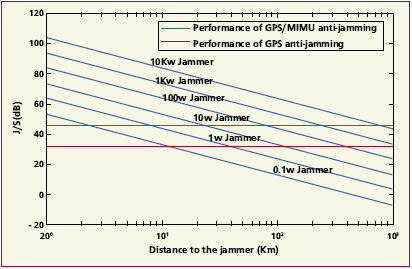| Navigation | |
Trends in GNSS/INS integrated navigation technology
|
In recent years, there have been some successful AI methods applied to GNSS/INS integration. Two artificial neural networks (ANN)- based INS/DGPS integration schemes for vehicular navigation were developed with a conjugate gradientbased training algorithm[7]. A new method is presented to improve the MEMS IMU/GPS performance using fuzzy modeling[8]. The GNSS/INS integration architecture using ANN which has the ability to mimic a human navigator, is capable of providing real time prediction and improve the performance during GNSS outages[9]. An Adaptive-Neuro-Fuzzy-inferencesystem (ANFIS)-KF model is used to correct the estimated KF outputs, which adopts Fuzzy-OLS algorithm for online ANFIS adaptive learning and impairs the influence of MEMSIMU thermal variation by ANFIS[10]. Three AI-based methods, that is, a fuzzy logic rule-based system, a fuzzy expert vehicle dynamics identification system and a neural networks-based compass calibration algorithm, have been developed for GPS/MEMS INS integrated system[11]. We consider a case study that illustrates performance benefits of RDSS/INS integration[12]. In the case, the horizontal accuracy of RDSS positioning is 100 m and the minimum interval of positioning is 1.5 s because of active positioning mode. A tactical-grade IMU is used. Table 1 shows comparison of positioning error using five algorithms with same experimental data. BPNN aided KF Fig.2 Performance of GPS/MIMU antijamming vs. GPS anti-jamming has a best position accuracy. BPNN algorithm is also quite good. KF based on fuzzy inference is a little better than Sage-Husa adaptive KF. This indicates that algorithms with AI techniques improve positioning accuracy. ConclusionIt can be seen from the above analyses that GNSS/INS integrated systems will benefit from deep integration architecture and AI technology. Some instructive researches have been set up recently, but it is just a beginning. Overall, we believe that the trends of deep integration and intelligent integration would be referred clearly as one of the most important directions during the wide applications of the integrated systems. As fabrication techniques of MEMS sensors develop increasingly, some manufacturers foresee that the gyro bias error of a 2 in3-sized MEMSbased IMU will be achieved to 0.010/h by 2010[13]. In addition, the low cost, lightweight, and high G of MEMS sensors are the driving factors in more and more applications. Integration involving deep integrated mode and AI techniques should be made more feasible and attractive. Based on this, a low-cost attitude determination GNSS/ MEMS INS integrated navigation system is likely to be designed. ReferencesR. BABU and J. WANG, “Improving the quality of IMUderived Doppler estimates for ultra-tight GPS/INS integration,” in GNSS2004, Rotterdam, The 2] E. J. Ohlmeyer, “Analysis of an Ultra-Tightly Coupled GPS/ INS System in Jamming,” in 2006 IEEE/ION, Position, Location, And Navigation Symposium, 2006, pp. 44-53. 3] S. Gunawardena, A. Soloviev, and F. v. Graas, “Real Time Implementation of Deeply Integrated Software GPS Receiver and Low Cost IMU for Processing Low-CNR GPS Signals,” in ION 60th Annual Meeting, Davton,OH, 2004, pp. 108-114. 4] R. BABU, “Mitigating the correlations in INS-aided GPS tracking loop measurements: A Kalman filter based approach,” in 17th Int. Tech. Meeting of the Satellite Division of the U.S. Institute of Navigation, Long Beach, California, 2004, pp. 1566-1574. 5] T. M. Buck, J. Wilmot, and M. J. Cook, “A High G, MEMS Based, Deeply Integrated, INS/GPS, Guidance, Navigation and Control Flight Management Unit,” in Position, Location, And Navigation Symposium, 2006 IEEE/ION, 2006. 6] J.Beser, S.Alexander, R.Crane, S.Rounds, J.Wyman, and B.Baeder, “A Low-Cost Guidance/Navigation Unit Integrating a SAASMBased GPS and MEMS IMU in a Deeply Coupled Mechanization,” in ION GPS Portland, 2002. 7] N. El-Sheimy, K.-W. Chiang, and A. Noureldin, “The Utilization of Artificial Neural Networks for Multisensor System Integration in Navigation and Positioning Instruments,” IEEE TRANSACTIONS ON INSTRUMENTATION AND MEASUREMENT, vol. 55, pp. 1606-1615, OCTOBER 2006. 8] W. Abdel- Hamid, T. Abdelazim, N. El-Sheimy, and G. Lachapelle, “Improvement of MEMS-IMU GPS performance using fuzzy modeling,” GPS Solution, vol. 10, pp. 1-11, 2006. 9] K.-W. Chiang, “INS/GPS Integration Using Neural Networks for Land Vehicular Navigation Applications,” in Department of Geomatics Engineering. vol. Doctor Calgary: University of Calgary, 2004. 10] W. Abdel-Hamid, “Accuracy Enhancement of Integrated MEMSIMU/ GPS Systems for Land Vehicular Navigation Applications,” in Department of Geomatics Engineering. vol. Doctor Calgary: University of Calgary, 2005. 11] J.-H. Wang, “Intelligent MEMS INS/GPS Integration For Land Vehicle Navigation,” in Department of Geomatics Engineering. vol. Doctor Calgary: University of Calgary, 2006. 12] H. Xiaofeng, W. Wenqi, T. Yonggang, and H. Xiao-ping, “Intelligent RDSS/INS Integrated Algorithms for Land Vehicle Navigation,” in Symposium Gyro Technology 2006, Stuttgart, Germany, 2006. 13] S. GT, “INS/GPS technology trends,” in NATO research and technology organization lecture series232 advances in navigation sensors and integration technology London, 2003 |
|||||||||||||||||||||||||||||
|
|||||||||||||||||||||||||||||
|
Pages: 1 2


















 (No Ratings Yet)
(No Ratings Yet)




